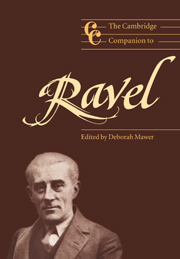Book contents
- Frontmatter
- Introduction
- Part I Culture and aesthetic
- Part II Musical explorations
- 4 Ravel and the piano
- 5 Harmony in the chamber music
- 6 Ravel and the orchestra
- 7 Ballet and the apotheosis of the dance
- 8 Vocal music and the lures of exoticism and irony
- 9 Ravel's operatic spectacles: L'Heure and L'Enfant
- Part III Performance and reception
- Appendix: Early reception of Ravel's music (1899–1939)
- Notes
- Select bibliography
- Index of names and works
7 - Ballet and the apotheosis of the dance
from Part II - Musical explorations
Published online by Cambridge University Press: 28 September 2011
- Frontmatter
- Introduction
- Part I Culture and aesthetic
- Part II Musical explorations
- 4 Ravel and the piano
- 5 Harmony in the chamber music
- 6 Ravel and the orchestra
- 7 Ballet and the apotheosis of the dance
- 8 Vocal music and the lures of exoticism and irony
- 9 Ravel's operatic spectacles: L'Heure and L'Enfant
- Part III Performance and reception
- Appendix: Early reception of Ravel's music (1899–1939)
- Notes
- Select bibliography
- Index of names and works
Summary
Ballet is the most lavish and unpractical kind of dancing. Steps are embellished at every point with little angles of the shoulder or head, decorative arm movements, beats and flourishes of the ankles or feet.
mackrellDance, that is to say stagnation, movement on the spot, the whirling action which, instead of being unleashed on the world, surges back on itself, finds its finality within itself, tramples and turns around.
jankélévitchThis chapter serves to point up the significant position of ballet within Ravel's smallish oeuvre, and the idea of dance forms as a way of connecting between music and choreography, focused on movement, phrases (enchaînements) and patterning. Additionally, these two arts share an interest in animating space and time; as Mackrell comments, ‘Space isn't simply a neutral area where the dance takes place. Like the stillness between movements, it's part of the dance itself’, and ‘It is rhythm too that allows choreographers to play with Time – to drive it forward, freeze it or make it race.’ Although music and choreography exist as autonomous arts, they may still come together for greater collective effect. Despite our main focus on the musical portrayal of dance, ideas from classical ballet and flamenco will influence analytical readings of Daphnis et Chloé, La Valse and Boléro (works whose main embodiment is as ballet rather than as piano music). The first quotation heading this chapter is used to encapsulate Ravel's highly stylised and varied approach to dance (exemplified by Daphnis); the second quotation suggests the obsession intrinsic to closed dance forms which leads to Ravel's ‘apotheosis of the dance’ as a glorified ideal, followed by its destruction in La Valse and Boléro. (For more on the ‘dance-machine’ trajectory, see Mawer, Chapter 3.)
- Type
- Chapter
- Information
- The Cambridge Companion to Ravel , pp. 140 - 161Publisher: Cambridge University PressPrint publication year: 2000
- 2
- Cited by



